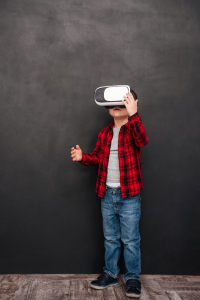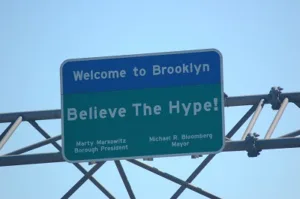There is so much hype surrounding VR in the education market nowadays, it seems particularly wise to stop and do a reality check, at least once in a great while. [Enticing]

 Although I am personally quite bullish on VR, this will not be another one of those cheerleading articles about the potential of VR in education. [Amazing] No, what I am about to report may prove downright depressing. [Inspiring]
Although I am personally quite bullish on VR, this will not be another one of those cheerleading articles about the potential of VR in education. [Amazing] No, what I am about to report may prove downright depressing. [Inspiring]
Thus, in order to keep readers from falling off the feared precipice of despair, I have deliberately embedded words of hope throughout this article, as seen in the very first paragraph, in [bracketed italics]. These are expressions that literally shout the promise and potential of virtual reality, while counterbalancing the bad news. [Elevating] These are words not just taken magically from the air, but actual text snatched from the VR-related exhibit hall booths and sales literature at a recent ed-tech conference, ‘designer’ phraseology that help sell VR to tech-hungry educators. [Engaging]
So, let’s start our 2018 VR reality check, which is based on a recent avalanche of data points occurring in schools, not in the artificially glorified environments of conferences and expo halls. [Democratizing education]
Is VR very popular in classrooms? [Pivotal] Unfortunately, I am seeing too few yeses and too many noes in the conversation. In the last three months, here is a flood of feedback about VR I have been receiving from educators or some of the insightful data I have come across:
No Show. One educator I spoke with told me how their school leaders, excited by the educational possibilities of using virtual reality in their public school classrooms, offered a dedicated break-out session on VR on their first “professional development day” for teachers. [Learning] This is a day when all children stay at home and educators attend critical trainings to upgrade their teaching skills. Not one teacher attended the VR session. No one. [Revolutionary]
No Go. In another public school, an elementary school, a district-level tech expert visited the school to offer a VR workshop (that, in this case, teachers were required to attend). [Transporting] According to one attendee, most teachers present at this workshop felt it wasn’t something immediately useful for them. Fast forward three months. Not a single teacher had taken up this technology in their classrooms. No takers. None. Zilch. [Impactful]
No Time. Laura Tickle, a K-5 technology coordinator at Ben Franklin Academy, a high-performing Charter school in Colorado, reported that “’zero’ teachers are using VR currently.” [Exciting] When asked to explain why, she responded: “Time would be the main issue with not using VR.” Teachers have so little of it. She added “and we do not have any equipment for it.” [A real turn-on]
No Priority. Joy Vigil, a middle school technology coach at a respected Colorado magnet school, The Academy of Charter Schools, noted that teachers at her school are also not yet using VR in instruction. [Illustrious] She explained, “This is due to lack of equipment and training”. And when schools don’t buy—and don’t train—it’s simply a technology that is not high up on their priority scale. [Powerful]
No More? Has Google conquered the education world, now that they are claiming more than 2 million Google Expedition users worldwide? [Enables exploration] Sounds like real penetration of the ed market, doesn’t it? Not really. First, their actual penetration rate is miniscule. UNICEF estimated there are 650 million children of primary age in the world, and nearly double that if you include secondary students. Based on these assumptions, Google has only reached 0.003 (less than a third of 1 percent) of elementary students worldwide, and only 0.0015 of all students, both primary and secondary. Second, “having used” (just once or a few times) is much different in schools than “are using” (daily, weekly, monthly, frequently). Sounds like hype, doesn’t it? You bet.
Only a Bit More. Google conquers the U.K. is what some people say, with over a half million students having used their singular Google Expeditions platform. [Builds understanding] But if you assume in excess of 10 million students in the U.K. at minimum, that converts into a 0.05 penetration rate. (And, of course, we must still own the “having used” versus “are using” verbiage.) Translated, more than 95% of UK students have not used Google Expeditions. Oh well.
Little or No Change. In my undergraduate classes at the University of Colorado-Denver I recently started a process of surveying each incoming cohort about their use of and experience with virtual reality. [Building imagination] Now I know there are problems with extrapolating from such small sample size—although I plan to collect these data for years to come—but the findings from my first two semesters clearly align with my experience interviewing past cohorts and knowledge of in-practice teachers, as well. Here are my current findings:
- 42% of UCD students have tried VR, which is up from 35.7% last year. Of course, that means 58% had never used it, prior to taking my classes.
- Only 3.5% of my students have used virtual reality in an way associated with their university coursework. What happened to the energy of virtual reality in the educational marketplace? It’s dismal.
- And, oh yeah, about 15.8% of my students get uncomfortably ill when viewing virtual reality. That makes sense, supported by worldwide vision health research.
I suppose, if you see the world pessimistically, that might mean that the penetration rate for this emerging technology in the ed market is far below the hype levels we all hear; but if you view the world with rose-colored glasses, you might see this as a fertile market. The bottom line problems with VR in education are well understood by educators. [Active] To educators, current VR experiences:
- cover very little of the written school curriculum
- are not easily managed in the classroom
- haven’t learned from the experiences and failures of the 3D in education movement of the last decade
- haven’t yet convinced teachers of their instructional merit
No, until virtual reality experiences can offer all of the requisite 4Es of education (engaging, effective, efficient, and easy to manage), we have a long way to go. [Immersive] —Len Scrogan

